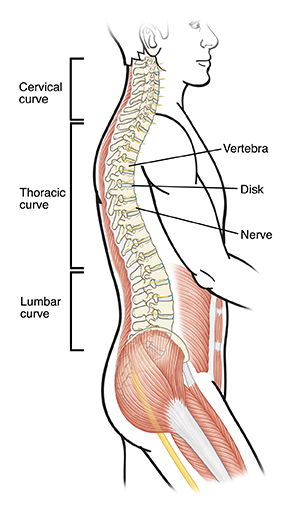Good Body Mechanics for Healthcare Workers
At work, you perform many tasks every day that could cause back injury. These include repeated lifting, prolonged standing, bending, twisting, reaching, pushing, and pulling. Protect your back by using good body mechanics to maintain the 3 natural curves of your spine.
A balanced spine
-
A balanced spine is made of bones (vertebrae) and pads of cartilage (disks) arranged in 3 natural curves.
-
Your neck (cervical curve) supports your head. And your middle back (thoracic curve) is supported by your rib cage.
-
Your lower back (lumbar curve) carries more than its fair share, balancing your entire upper body. This extra load and the mobility of the lumbar curve make it the most susceptible to injury. The core muscle groups (of the abdominal, gluteal, and hip regions) support the lumbar spine.
 |
| Good posture keeps your spine and muscles balanced, protecting your disks, nerves, and vertebrae from injury. |
Using good body mechanics
Moving your body correctly is a skill that requires your constant attention. How well you perfect the skill can mean the difference between a fatigued or injured back and a healthy back. Below are a few tips to help you use good body mechanics:
-
Hold loads close to your body to lessen the effect of their weight.
-
To prevent twisting injuries, move your torso—from your shoulders to your hips—as one solid unit.
-
Use a wide base of support (feet spread apart). Keep your knees bent to make your legs work harder, reducing the stress on your back.
-
Avoid quick, jerky movements.
-
Face the direction that you will be moving.
-
Never transfer patients when you are off balance or without assistance.
-
Tighten abdominal muscles to help support your movements.
© 2000-2024 The StayWell Company, LLC. All rights reserved. This information is not intended as a substitute for professional medical care. Always follow your healthcare professional's instructions.